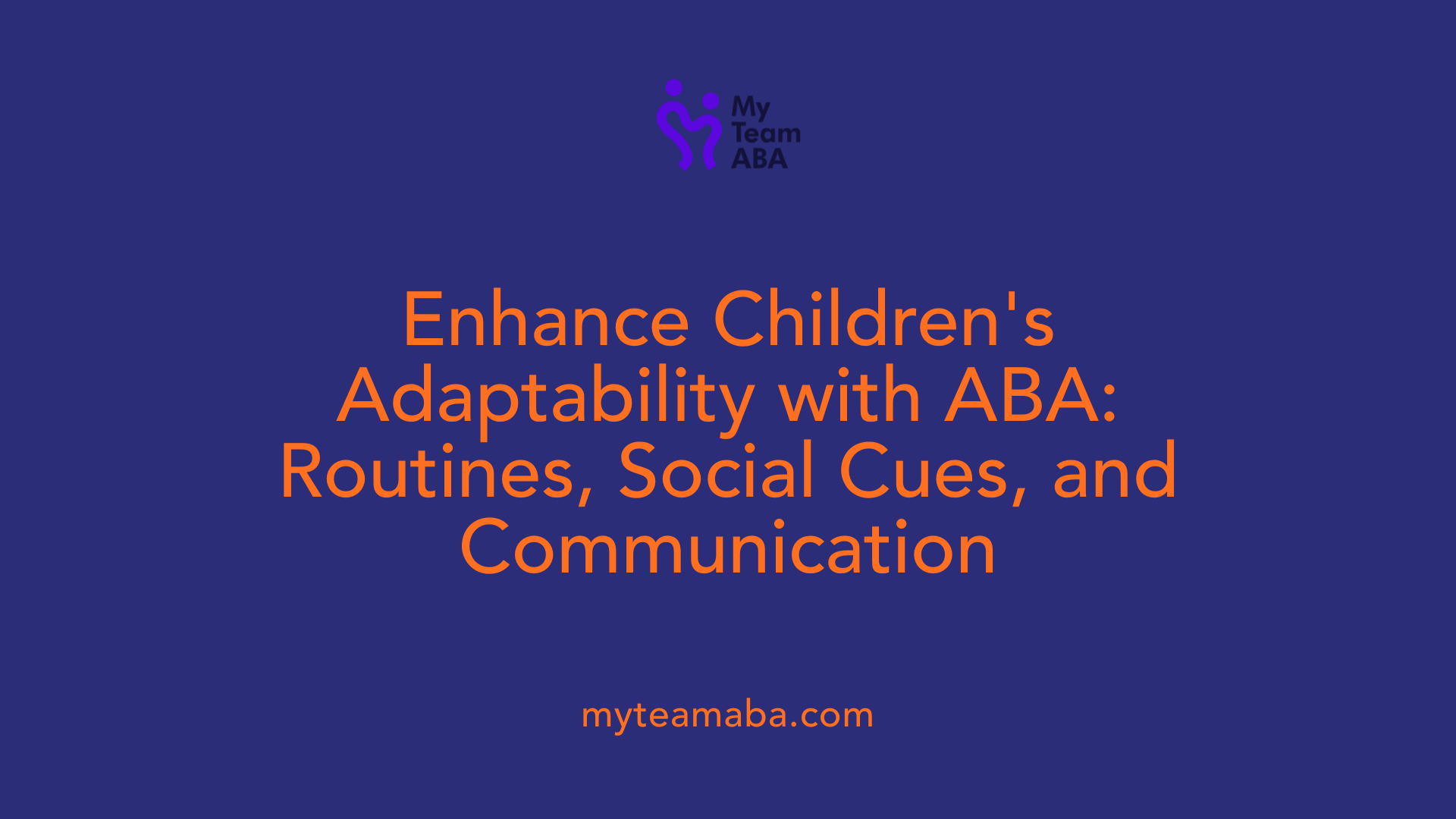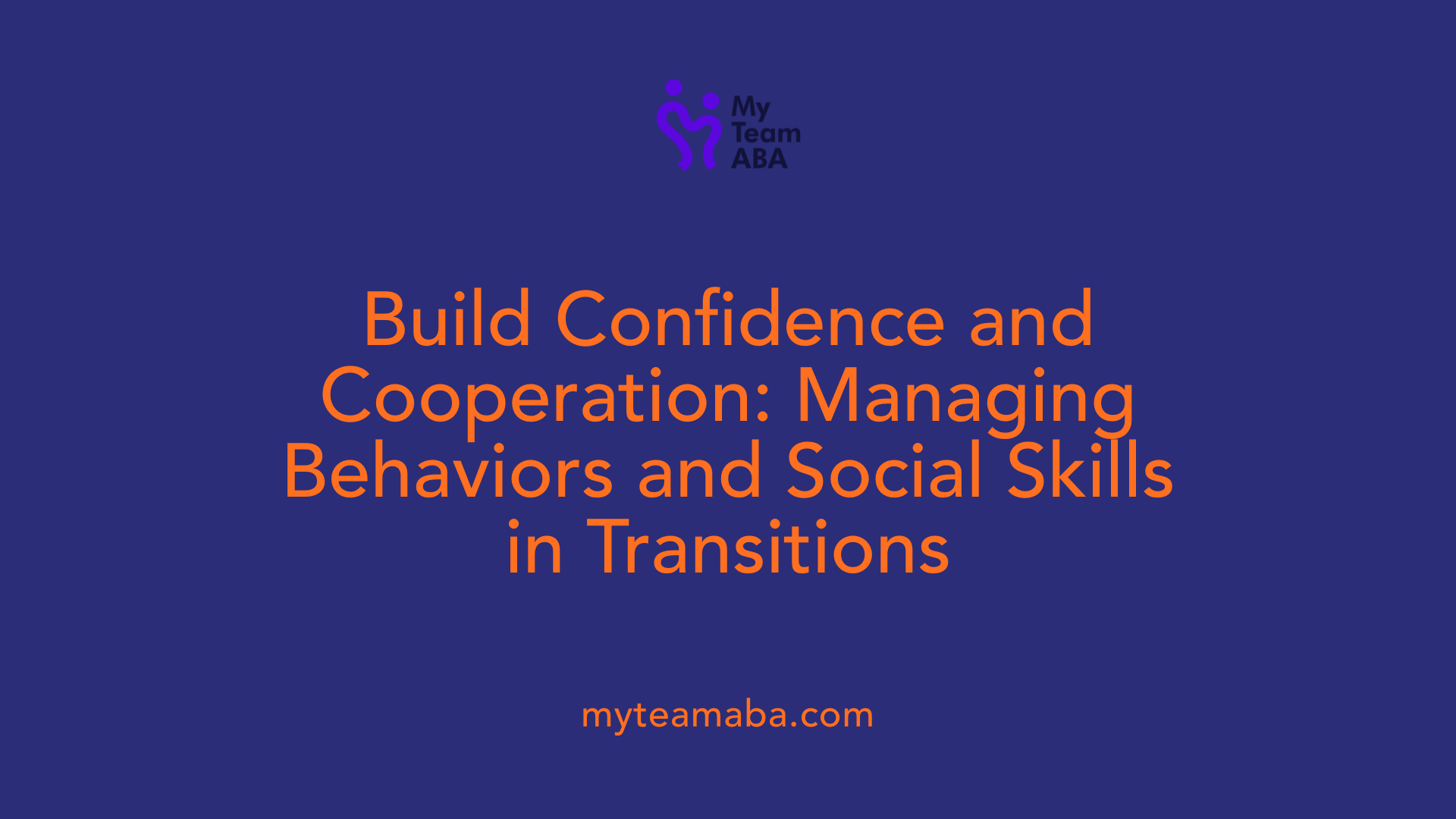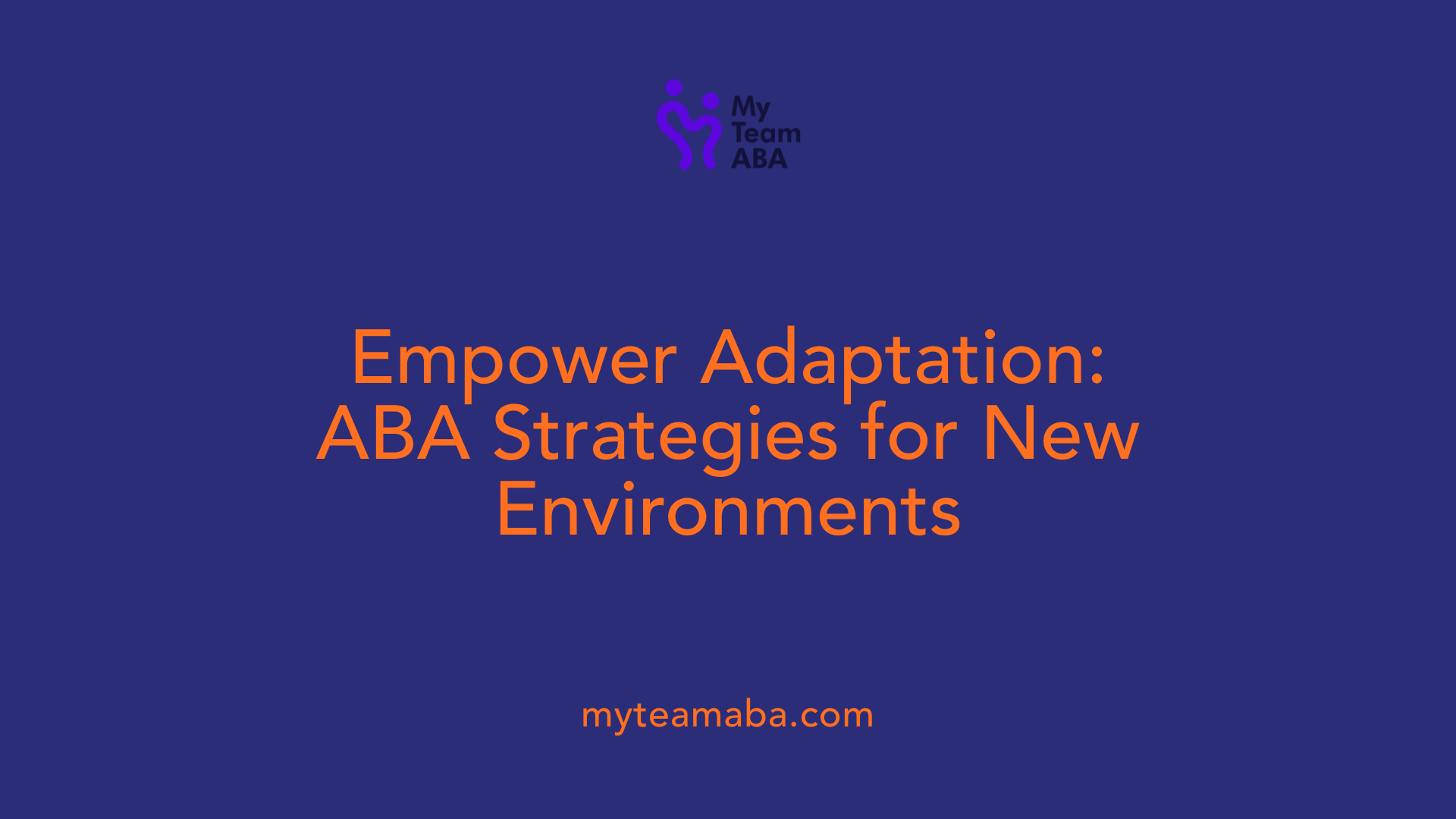How ABA Therapy Can Assist with Transitioning Between Environments
July 18, 2025
Supporting Seamless Transitions: The Power of ABA Therapy

Understanding the Role of ABA in Facilitating Environmental Changes
Transitions between different environments such as school, social settings, therapy sessions, or the workplace can pose significant challenges for individuals with autism and developmental disabilities. These transitions often trigger stress, behavioral issues, or social withdrawal due to sensory sensitivities, communication difficulties, and anxiety. Applied Behavior Analysis (ABA) therapy offers a structured, evidence-based approach that helps individuals adapt smoothly and confidently to new settings. This article explores how ABA supports transitions across environments, the strategies involved, and the long-term benefits for individuals at various stages of life.
Foundational Skills that Support Transitions in Children

How does ABA therapy support transitions between different environments?
ABA therapy plays an essential role in helping children with autism manage transitions, whether shifting from home to school, from one activity to another, or between different social settings. One of the primary ways ABA accomplishes this is by teaching children skills like following routines, understanding social cues, and effective communication—all crucial for adaptability.
Visual supports are a cornerstone of ABA strategies. Tools such as visual schedules, timers, and countdowns help children anticipate upcoming changes, which reduces anxiety and feelings of uncertainty. For example, a visual schedule might show pictures representing each part of the day, helping a child understand what comes next.
Additional techniques include the use of First-Then boards, transitional objects, and clear warnings or visual cues to prepare children mentally and emotionally for changes. These strategies give children a sense of predictability and control, making transitions less overwhelming.
Reinforcing successful transitions with praise, tokens, or other preferred items encourages positive behavior and boosts a child's confidence in managing change. Through this structured approach, ABA creates a predictable environment that supports emotional regulation.
Overall, ABA combines structured routines, visual aids, and behavioral reinforcement to make transitions smoother and less stressful. The goal is to foster independence and resilience, enabling children with autism to move confidently between different environments and activities with minimal distress.
Strategies for Smoother Transitions Using Visual Support and Reinforcement

What strategies does ABA therapy use to facilitate smooth transitions?
ABA therapy utilizes multiple approaches to help children with autism navigate transitions smoothly. One primary method involves visual supports, such as visual schedules and social stories. These tools visually depict the sequence of activities, making changes predictable and easier to understand.
Transition objects, like a favorite toy or item, can also serve as comforting cues during changes. Reinforcement strategies are employed to reward successful transitions, encouraging positive behavior and compliance.
Gradual exposure is another effective technique. It involves exposing the individual to new routines or environments in incremental steps. This might include short visits or practice sessions that gradually increase in duration, helping reduce anxiety and increase familiarity.
Auditory cues, such as timers or calming music, assist in signaling upcoming changes. Sensory and calming techniques, including deep breathing, sensory toys, or calming visuals, help manage emotional responses during transitions.
Consistent practice and tailoring these supports to each child's unique needs maximize their benefits. When strategies are applied across different settings—home, school, or therapy clinics—they foster independence and build confidence in handling change.
Managing Behavioral and Social Skills During Transitions

How does ABA therapy help individuals manage behavioral and social skills during transitions?
ABA therapy plays a vital role in supporting children and young adults with autism through the often challenging process of transitions. It equips individuals with essential coping strategies, promoting adaptability and reducing stress during shifts between activities, environments, or social situations.
One of the foundational approaches in ABA is teaching flexibility—helping individuals accept and adapt to change through specific behavioral techniques. Therapists utilize visual supports such as visual schedules, transition cards, timers, and social stories. These tools serve to increase predictability, which is often a concern for children with autism, thereby calming anxiety and preventing disruptive behaviors.
In addition to visual aids, ABA advocates for proactive strategies like providing advance warnings before transitions, offering choices to empower independence, and gradually fading prompts to encourage self-sufficiency. Making transitions engaging—by incorporating preferred activities, using timers, or adding fun elements—can ease discomfort and foster cooperation.
Moreover, effective ABA intervention emphasizes collaboration with caregivers and educators to create consistent routines, which further support smooth changes. By tailoring strategies to each individual's needs, ABA helps improve behavior, build confidence, and foster social skills essential during transitions.
Overall, ABA therapy's comprehensive and individualized methods foster greater behavioral resilience and social competence, ensuring children feel more comfortable and capable during life's many changes.
Supporting Transitions from One Therapy Setting to Another
 Planning effective transitions between different therapy environments, such as moving from in-home to center-based ABA therapy or transitioning into school settings, is crucial for maintaining progress and reducing stress for children with autism.
Planning effective transitions between different therapy environments, such as moving from in-home to center-based ABA therapy or transitioning into school settings, is crucial for maintaining progress and reducing stress for children with autism.
A thoughtful approach involves clear planning that considers the child’s routines, preferences, and specific needs. For example, establishing a structured routine that gradually introduces new settings helps the child become familiar and comfortable with change.
Visual supports play a vital role in facilitating smooth transitions. Tools like visual schedules, social stories, transition cards, and checklists give children visual cues about what to expect, reducing uncertainty and anxiety. Clear discharge or transfer criteria ensure everyone understands when a child is ready to move, providing a sense of closure and preparation.
Collaboration among therapists, parents, and educators creates a cohesive strategy that promotes consistency. Regular communication about progress, challenges, and upcoming transitions helps tailor approaches that suit each child's unique situation.
Developing practical social skills is also essential. Children learn to ask for help, make eye contact, and initiate conversations during transition periods, which supports their integration into new environments.
Overall, ABA therapy emphasizes proactive and individualized planning, fostering skills that make transitions less stressful and more successful. By combining visual supports, collaboration, and social skill development, children gain confidence and independence, easing their journey through various therapy and social settings.
| Transition Type | Strategies Used | Goals | Supporting Details |
|---|---|---|---|
| In-home to Center | Gradual exposure, visual schedules | Familiarity, comfort | Use visual supports to prepare for changes |
| Therapy to School | Collaboration, social stories | Academic and social readiness | Coordinate with educators, practice routines |
| Center to Community | Role-playing, social skills | Practical social interaction | Practice real-life scenarios in safe settings |
| Therapy to Workplace | Vocational skills training, coping strategies | Independence, employment readiness | Collaborate with employers, reinforce skills |
Effective planning hinges on assessing each child's ability to manage environmental changes, using functional assessments when necessary, especially for children who struggle with verbal cues or experience sensory sensitivities. Overall, successful transitions depend on open communication, tailored strategies, and a supportive, structured environment, ensuring children experience minimal disruption and maximum growth in their social and behavioral skills.
The Role of ABA in Helping Individuals Adapt to New Environments

What is the role of ABA therapy in helping individuals with autism and developmental disabilities adapt to new environments?
ABA therapy is essential in supporting individuals with autism and other developmental disabilities as they face new settings and routines. It offers personalized, structured interventions designed to teach necessary skills like communication, social interaction, and daily life management.
One of ABA’s strengths is the use of visual supports, such as schedules, social stories, and checklists, which help create predictability. This predictability reduces anxiety and makes transitions less overwhelming.
ABA strategies also involve modifications to the environment, including designated calm zones or sensory accommodations, to help individuals remain comfortable during changes. The therapy emphasizes positive reinforcement of desirable behaviors and independence, enabling individuals to navigate unfamiliar settings confidently.
Furthermore, ABA programs often incorporate collaboration with other professionals, such as speech therapists, occupational therapists, and educators, creating a comprehensive support system. This interdisciplinary approach ensures skills learned are reinforced across various environments, fostering generalization.
By breaking down tasks into manageable steps, providing consistent cues, and offering clear routines, ABA helps children transition smoothly. Over time, these interventions build resilience and independence, empowering individuals to adapt successfully and improve their quality of life.
ABA for Workforce Transition and Career Development in Young Adults
How does ABA therapy influence the ability of young adults with autism to transition into the workforce?
ABA therapy has a proven impact on helping young adults with autism succeed in entering the workforce. It provides targeted interventions that develop vital workplace skills such as effective communication, social interaction, self-advocacy, and organizational abilities.
One notable example is the JobTIPS program, which uses innovative tools like web-based platforms and virtual reality scenarios to simulate real job interviews and workplace situations. These methods help young adults practice and enhance their social competence and interview skills.
In addition to skill development, ABA supports the understanding and management of sensory or environmental challenges often faced in work settings. Techniques include establishing sensory accommodations, using positive reinforcement, and teaching self-regulation strategies, which help individuals adapt to diverse workplace environments.
A crucial aspect of ABA's role in workforce readiness involves comprehensive transition planning. Early assessments, collaboration with employment specialists and educators, and continuous skill-building are key. These efforts aim to prepare individuals for real-world job demands and reduce anxiety related to new routines.
Advantages of ABA in employment include harnessing strengths like reliability, attention to detail, and commitment—traits often found in autistic individuals. ABA interventions promote independence, punctuality, and task completion, which are highly valued in workplaces.
Long-term support and integration strategies involve ongoing coaching, workplace modifications, and mentorship programs. These ensure sustained employment and help individuals navigate challenges, promote social inclusion, and achieve career satisfaction.
In summary, ABA therapy facilitates a structured pathway for young adults with autism to develop critical skills, adapt to employment environments, and thrive in their careers. Its tailored approaches, combined with collaboration among therapists, employers, and families, are essential for successful transition to competitive work settings.
Empowering Transitions for a Better Future
Through targeted skills development, visual supports, and collaborative planning, ABA therapy empowers individuals with autism to navigate complex and changing environments with confidence and independence. Its adaptability means it can support early childhood school readiness, social and behavioral adjustment, seamless transitions between therapy settings, and successful entry into the workforce. As research continues to affirm its effectiveness, ABA remains a cornerstone of comprehensive support that enhances quality of life by promoting independence, social inclusion, and resilience across life stages.
References
- How In-Home ABA Therapy Helps Children Transition to School and ...
- The Role of ABA in Transitioning Young Adults with Autism
- How ABA Therapy Can Help In School
- What North Texas Parents Need to Know About Switching to In ...
- ABA Therapy In-Home vs At a Center: 5 Key Differences
- Applied Behavior Analysis (ABA) | Autism Speaks
- Helping Kids Transition Successfully in ABA Therapy | Childwise
- Child Development - Choosing Between ABA therapy and School
- Early Intervention for Autism: How ABA Can Help Your Child Thrive
- Advance Notice for Transition-Related Problem Behavior: Practice ...
